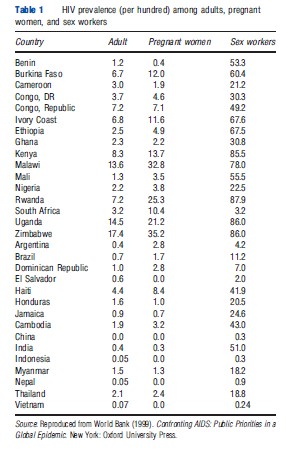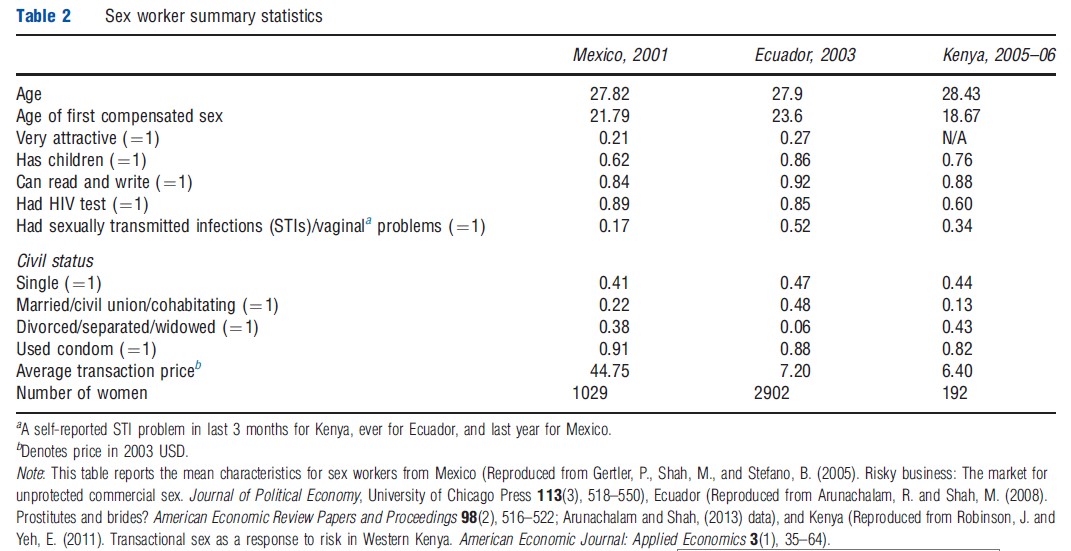Introduction
The literature on the economics of sex work in developing countries has been a burgeoning area of recent growth for various reasons. First, unprotected commercial sex is a major human immunodeficiency virus (HIV) transmission vector. Sex markets play an integral role in the spread of sexually transmitted infections (STIs) including HIV/acquired immunodeficiency syndrome (AIDS). Each day 20 000 people become infected with HIV (UNAIDS, 2002), and many of these new infections occur in the developing world. In developing countries, sex workers play a central role in the spread of HIV and other STIs as they generally have higher infection rates and more sexual partners relative to the general population. Table 1 displays HIV prevalence for adults, pregnant women, and sex workers across the developing world. In almost every country, sex workers have significantly higher HIV prevalence than the general population. In countries like Kenya, 85.5% of sex workers are HIV positive relative to 8.3% for the general adult population. Although condoms are an effective defense against infection, and despite the large amounts of financial aid channeled into educating sex workers about the importance of condom use, many sex workers are risking infection by not using condoms. Research in economics has sought to understand this issue because HIV/AIDS and other STIs have potentially devastating implications for economic development.

Second, the sex market is a large source of employment for many women in poor countries, which has both microeconomic and macroeconomic implications. Vandepitte et al. (2006) estimate the percentage of females who make their living from sex work to be 12% in Diego-Suarez, Madagascar; 4.3% in Ouagadougou, Burkina Faso; 2.8% in Phnom Penh, Cambodia; 1.4% in Jakarta, Indonesia; and 7.4% in Belize. Obviously these are significant numbers and constitute a large number of women earning their living by performing potentially risky work. In addition, these numbers are increasing as more women enter the sex market due to lack of outside labor market opportunities in most developing countries. On a macroscale, the amount of revenue associated with the sex sector is considerable. For example, revenue from the Indonesian sex sector was estimated at between US$1.2 and 3.3 billion, or between 0.8% and 2.4% of the country’s gross domestic product (Lim, 1998). In Thailand, close to US$300 million is transferred annually from urban sex workers to rural areas in the form of remittances (Lim, 1998). Therefore, both the financial turnover and the sheer number of women involved in the sex industry are strong motivators for further economics research.
Lastly, from an economics perspective, very little is known about the commercial sex sector, as demonstrated by the numerous policy failures. For example, many interventions aimed at teaching sex workers the alternate skills necessary to get them out of the sex industry have failed. The simplest explanation for this failure is that sex work pays well and most alternative low-skilled jobs do not, so getting women out of the sex industry is incredibly difficult. As another example, despite all the international funding that has been spent on educating sex workers about the risk of diseases such as HIV/AIDS, high rates of risky behavior (i.e., noncondom sex) are still observed in many developing countries.
This article investigates the following questions in the context of developing countries using recent studies from the economics literature:
- Why might women enter the sex market?
- Why do female sex workers engage in noncondom use?
To properly set the stage, this article begins with a brief description of sex workers’ sociodemographics and transaction characteristics from three different countries: Mexico, Ecuador, and Kenya.
Sex Worker Characteristics
Table 2 presents summary statistics of samples of sex workers in Mexico, Ecuador, and Kenya. The Mexican statistics are constructed from the dataset used in Gertler et al. (2005), the Ecuadoran statistics from the dataset used in Arunachalam and Shah (2008, 2013), and the Kenyan summary statistics from data used by Robinson and Yeh (2011). Please see the papers for more detailed information on sampling techniques and data collection activities. Interestingly, sex workers across all these three countries appear to be quite similar in terms of their sociodemographics. They are on average 28 years old, and the vast majority can read and write. Almost 50% are currently married or in civil union partnerships or were married and now are divorced, and more than 60% have children.

The majority of these women have taken HIV tests (89% in Mexico, 85% in Ecuador, and 60% in Kenya). In the past year, 17% of sex workers in Mexico self-reported having STI-related problems, 52% of women in Ecuador reported having an STI problem in the past, and 34% of women in Kenya reported STIrelated problems in the past 3 months. Although HIV/AIDS rates tend to be much lower in Mexico and Ecuador (approximately 1% among sex workers), STI rates are relatively high, especially compared to the general adult population in these countries. High STI rates in a population are a risk factor for a potential HIV/AIDS epidemic because untreated STIs facilitate easier transmission of the HIV virus. Condom use rates range on average from 80% to 90% in the last three sexual transactions. The average transaction price varied from approximately US$45 in Mexico to US$7 in Ecuador to US$6.50 in Kenya.